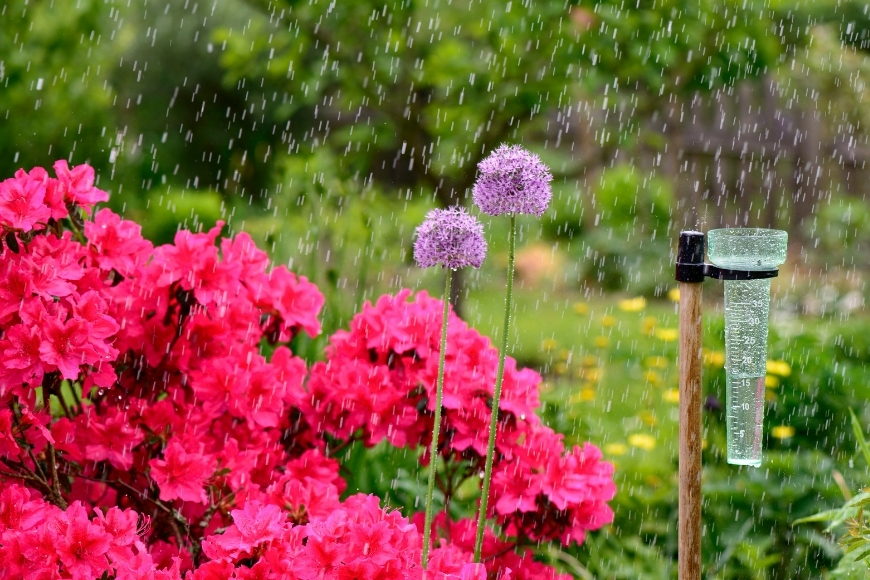
There are few things that will put a damper on your summer, like a waterlogged lawn. When your garden beds are soggy and you wind up ankles-deep in mud, it can be difficult to enjoy the beauty of your yard.
Luckily, you can improve the drainage of your lawn on your own. If you want to dry out your mosquito larvae nursery and step into your grass with confidence, we have the information you need.
Why You Don’t Want a Waterlogged Lawn
When your yard turns into a lake, the excessive water can do serious damage. Sitting water fills in the open spaces in the ground where roots pull in oxygen. Without oxygen, your grass and garden plants begin to suffocate below the surface.
Too much water also causes your plants to develop a shallower root system since the water prevents them from diving deeper. This makes plants more susceptible to disease and more likely to die from stresses like insects.
Meanwhile, as the plants you adore flounder, weeds that thrive in wet conditions take hold and can push out other plants.
So, How Can You Fix Your Soggy Lawn?
Increase opportunities for your grass to drain. While it’s important to wait for your lawn to fully dry before treading across it, you can begin planning now. We recommend a combination of these methods, depending on your conditions and budget:
Aerate Your Grass
The process of aerating your lawn creates spaces where air can penetrate the surface. These gaps also allow water to evaporate.
To aerate your yard, you can use a large garden fork and drive it in about every foot. You can also wear aeration shoes and practice your tap dancing skills. Of course, you can also ask a lawn care business how much they charge.
Install a French Drain
A French drain will pull in and direct water away from your lawn and garden. To DIY an effective French drain:
- Map out where water is sitting to where it needs to go. It will need to travel downward at a minimum of a 1% slope. Never direct water toward your house.
- Dig a trench along the drainage route. It should be about a foot-and-a-half deep and about a foot wide.
- Measure the length, depth, and width of the trench. Then buy enough 6-inch wide pipe to travel the length. You will also need water-permeable fabric that will lay flat in the trench with excess fabric on each side.
- Calculate the volume of the trench and estimate the amount of gravel you will need, minus the pipe.
- Lay the fabric into the trench, then lay about 3 inches of gravel.
- Lay the pipe onto the gravel. Using your hose, spray water into the highest point of the pipe. The water should run to the other end and out.
- Drill ½-inch holes every few inches in the pipe.
- Cover your pipe with gravel and pull the excess fabric up and around the gravel (like a pigs-in-a-blanket).
- Fill in the remaining space with backfill soil from the trench.
Plant a Rain Garden
Digging a ditch nearby your garden gives the water a place to go, but can cause erosion issues and create an eyesore. A rain garden on the other hand gives you the opportunity to have fun with water-happy plants while soaking up extra water.
To create a rain garden, find the lower end of where water sits in your yard. Dig down at a gentle angle, creating a small pond-like structure.
Add various plants that hold up well to temporary increases in water volume. A rain garden pocket pack can make quick work of selecting plants.
Some of our favorite rain garden plants include:
- Black-eyed Susans
- Sedges
- Bluestar
- Turtlehead
- Swamp milkweed
- Willow
Replace Your Paths with Permeable Options
Most pavers, driveways, and hardscapes repel water, causing it to rush to other areas of your yard. Replacing your old pavers with permeable options that absorb and hold water allows your yard to drain better.
Mulch makes for an excellent permeable path. Gravel also holds more water than pavers.
Rain, Rain Everywhere, and Plenty to Collect
Adding new hardscaping in the form of decorative rain barrels can do wonders for your soggy yard.
Not only does collecting rain from your downspouts prevent the water from flooding through your yard, but it’s also a great option to conserve water for your plants once the weather turns drier.
You rain barrels don’t have to just collect water. You can create a container water garden that refills itself and adds a new layer to your garden.
The Grass is Greener on the Drier Side
As summer storms continue to let down, begin preparing your next steps for draining your yard of its excess water. Aerating, adding a French drain, and investing in water-friendly plants in a rain garden or container water garden are great places to start.
Ready to start your rain garden? Check out our summer selection of water-wise plants.
Happy planting!
